PAMS Choice is the official Korean Performing Arts productions, which are more likely to be presented on the Korean Contemporary Performing Arts scene aimed at reaching a global audience. The PAMS Choice selections enjoy official showcase presentations throughout PAMS 2014 and are the subject of intensive promotional efforts at various international performing arts markets, with support provided for airfare and transportation when pieces are invited for performance overseas (in conjunction with the Arts Council Korea), for the translation of captions, and for education and consultation toward developing strategies to reach global audiences.
A total of 140 works were selected for PAMS Choice performances between 2005 and 2013. These performances have also been active abroad, with over 630 performances staged around Asia, Oceania, Northern America, Europe, among other diverse locations through the support of strategic overseas expansion. For 2014, a total of ten works have been selected. Partial and full showcases will be taking place over the PAMS event period at locations such as the Sejong Center for the Performing Arts, the National Theater of Korea and the National Theater Company of Korea.
The PAMS Choice 2014 Selections
* This is odered by showcase schedule.
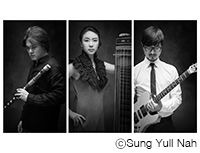 |
Black String - Black String |
New sound full of intensity, mystique and beauty.
Black string seeks for a new sound that can synthesize a variety of musical expressions into traditional music, as well as to harmonize with other expressions of world music.
The new sound will be reinterpreted by artists who embrace traditional music as well as jazz, involving composed as well as improvised creations.
The project especially focuses on improvisation as an important aspect of Korean traditional music and attempts to create a unique language through Asian intuition and musical idiom.The music of Black String is based on Korean musical traditions and will offer a fresh, new sound to audiences. Black String will offer an experience that broadens the world music audience’s appreciation by presenting an ancient tradition within a modern setting.
|
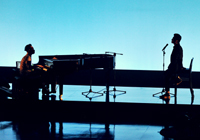 |
Han Seung Seok & Jung Jaeil - bari, abandoned |
The elegant combination of Korean pansori and piano portrays abandonment, forsakenness, forgiveness and salvation!
Korea’s representative myth of a female, “The Tale of Princess Bari,” has been recreated and placed into the modern context as a world music project under the name bari, abandoned. The myth has been brought to life by the vocals of Han Seung Seok, the rendition of Jung Jaeil and the lyrics of the playwright, Pai Sam Shik. The cohesion of pansori and the piano depicts life at the time of the Bari Mythology by expressing a message of salvation and solace to the modern world, which has been filled with conflict, division, isolation and hurt. Musically, pansori combined with piano and other traditional and modern instruments, such as guitar, bass, orchestration, computer programming, janggo, kwaenggari, jing, piri and taepyongso, all bring together an alluring melody that is beyond a simple infusion of Western and Eastern Sounds. All three performances of bari, abandoned at this year’s Yeowoorak Festival were completely sold out and it has become one of the hottest performances of 2014 in Korean cultural fields.
|
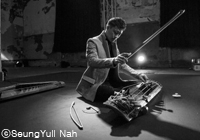 |
Performing arts consulting group BEONDI - PARK Woo-jae Geomungo Extension |
A magical sound that challenges the notion of tradition.
PARK Woo-jae Geomungo Extension
A geomungo, or a Korean traditional six-stringed zither, was traditionally a scholar’s instrument. Since the geomungo was previously not welcomed in a contemporary orchestra/ensemble setting, PARK Woo-jae began to develop the geomungo as a solo instrument.
PARK Woo-jae Geomungo Extension is a piece that combines the traditional technique of using a suldae (or a short bamboo stick), a hand technique and a unique method of using a bow while flipping the instrument. Also, the sound director employs a design that uses the entire performance space. Through the combination of PARK Woo-jae’s geomungo performance and sound director KIM Byoung-keuk’s sound design, the voluminous sound of both the live performance and recorded music emanate to the audience.
|
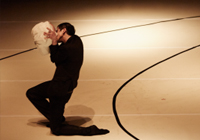 |
GROUND ZERO Project - Agape |
A mise-en-scène using the symbolism of the body and the iconography of medieval painting!
This work presents the motif of Agape, the absolute and complete love of God toward mankind, through a mise-en-scène created using a variety of objets d'art and stage art. The scene also uses a language of performance that deploys the symbolism of the human body in order to reflect on the sinful nature of mankind and its desire for a transcendent being.
By appropriating the iconography, symbolism and arrangement of the body and images found in medieval painting, the artist attempts to transform the planar composition of painting into a three-dimensional space. A new aesthetic emerges from converting pictorial images that used to exist in a fixed, planar frame into an eventful, temporal art form with performative and site-specific elements.
|
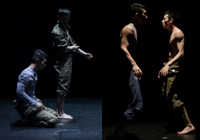 |
Company SIGA - Rest |
Ball bouncing ceaselessly. Body energy bursting continuously. Now, rush to take a break.
In Rest, Lee Jae-young wanted to represent the eagerness and emptiness of relaxation by offering the flexible and organic movements of a basketball. By using the image of a ball in constant motion, and the burning out and fatigue from continuous exercise, he portrays the desperation to relax and its subsequent emptiness. After he is finished running, at the very moment when all body movement has totally stopped, it is the relaxation, that is, the emptiness that is the subject of the piece. To express the fatigue from continuous exercise, and the subsequent eagerness for relaxation, and the emptiness that comes through relaxation, these images are juxtaposed with a basketball that constantly bounces so that the audience can finally breathe and empathize together, ameliorating the tension.
|
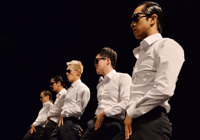 |
Ambiguous Dance Company - Rhythm of Human |
All human beings live as if they are dancing!
Every moving and breathing creature takes form as though in a rhythm, movement and expression of dance. Nevertheless, we fail to recognize that, on the whole, what we regard as “beating to our own drum” gets lost in the rhythm of society. Fortunately, we humans can seek to rediscover the rhythms within us. With this in mind, the choreographer tells a story about the difficulty and beauty of reclaiming the freedom of expression. Moreover, as a message of vitality, this performance speaks to the essential nature of dance and its ubiquitous presence in our lives.
|
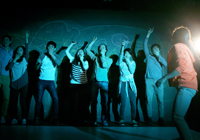 |
Theatre Company Nolddang - SEE |
A bust symposium of composition where people only use the verb ‘SEE.’
The play is conceived from a question: "Isn't it possible to make a play by only appealing to visual perceptions?" Because people believe and expect that they can approach the essence of something through the visual, which is usually immediate and strong. The play comprises 15 individual episodes that contain discussions, examinations and personal memories. The audience will be challenged to understand the act of ‘seeing’ in a new way.
|
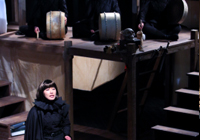 |
TAROO - Pansori Hamlet Project |
The true Hamlet story where Hamlet’s monologue interleaves with the main parts of Pansori!
The Pansori Hamlet Project is a work emphasizing Hamlet’s agony by splitting Hamlet’s character into four people. This work thoroughly shows the agony of a young person’s process of overcoming obstacles, identifying his father’s undeserved death, and reinterpreting the story of the true Hamlet as Hamlet himself narrates it. Hamlet’s soliloquy consists of dialogues between the Hamlets, Ophelia’s conversation is composed of songs, and the sword fighting scene between Hamlet and Laertes is combined with the climax of the Pansori, resulting in a vivid and tense Pansori scene. Hamlet’s agony and the sense of morbidity in the original work, are reinterpreted and revitalized. And at last, during the show’s climax, the intense gravity of the classic is alleviated and Pansori Hamlet depicts a Hamlet that is not too different from us all.
|
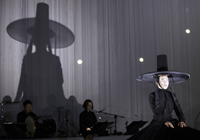 |
Lee Hee-moon Company - Order-made Repertory ZAP |
Crowded and strange, therefore this song exists!
Zapga (folk songs) is a subcategory of Korean traditional vocal music. Sung by professional sorikkun, Zapga was a popular form of music during the Joseon era. The twelve total pieces that have survived until today are called “The Twelve Zapga.”
“Zap” literally means “miscellaneous, crude.” In contradiction to its definition, however, the performance of Zapga requires highly skilled vocalists: an interesting phenomenon where a genre of music, once situated at the lowest rung in the past, has now become highly regarded.
Lee Hee-moon and his colleagues gathered together, believing that the combination of each member’s unique personality would enrich the meaning of the deprecated word “Zap.” Their goal was to revive the art of Zapga, and through their performances, they hope that the lyrics and story of Zapga will share this unique beauty and pleasure with their audiences.
|
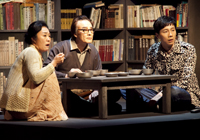 |
Dream play These21 - Chronicle of Alibis |
Documentary, Epic, Beyond Theater “Encountering, Oh My President?!”
"A chronicle that is very ordinary and yet political”
The father, who is a graduate of the Republic of Korea Field Artillery School, and who fought in the Korean War as a corporal, is shedding tears in front of a boot camp. He is waiting for his youngest son who has just completed a four-week long boot camp before serving his military duty as a public officer. His older brother was a war veteran, and all his nephews and sons have already served the country as corporals. What was the reason behind his tears?
※ Full length case in cooperation with SPAF(Seoul Performing Arts Festival). Since the seats are limited, reservation should be a priority. (First-come, first-served basis)
|

























































